30 October 2023
![]() 13 mins Read
13 mins Read
Hamilton Island is home to a raft of accommodation options including holiday homes and the breezy Palm Bungalows as well as world-class luxury resort qualia. It’s well placed for exploring nearby Whitehaven Beach, and is the only spot that offers an exclusive adventure to the newly opened Heart Island: a luxury and sustainably designed pontoon located in the neighbouring lagoon to Heart Reef.
Daydream Island has 280 rooms and suites and three restaurants and bars to choose from and its Living Reef: an eco-friendly and educational coral lagoon that wraps around the property and offers opportunities to encounter baby stingrays, spot starfish and sea cucumbers and discover more than 100 unique species of marine fish.
The iconic private island resort Hayman Island offers the choice of 168 pitch-perfect rooms, suites and villas that blend artfully with the resort’s tropical gardens, ever-beckoning pools and panoramic seascapes, in addition to five distinct dining experiences. It places you on the doorstep of Langford Island, Blue Pearl Bay and Hook Island.
The first 100 per cent solar-powered resort on the Great Barrier Reef, Elysian Retreat occupies a secluded three-hectare patch of Long Island, that’s ensconced by rainforest and reef. A boutique eco experience for up to just 20 guests at a time, it offers a locally sourced custom menu, an Ayurveda inspired spa, morning yoga sessions, paddleboarding and kayaking.
There are several options for beach camping on Whitsunday Island, the largest of the archipelago, including right on the fringe of Whitehaven, with 10 campsites nestled behind the beach among lowland vine forest and eucalypt woodland. You can beach camp in other spots in the Whitsundays National Park, including several sites on rugged Hook Island.
The Whitsundays are the only place in the world where you can rent a multimillion-dollar yacht without a licence. There are plenty of bareboating options to choose from, where you’ll essentially hire a houseboat with friends or family to languorously explore the secluded bays and beaches of the Whitsundays’ 74 islands. There are also plenty of tours and skippered boats to choose from; Cruise Whitsundays is a good place to start.
Eco Barge Clean Seas Inc. has been running the Whitsunday Marine Debris Removal Program for over a decade and has removed more than 179,000 kilograms of marine debris from the waters. And those wanting to contribute can volunteer on one of its barge trips.
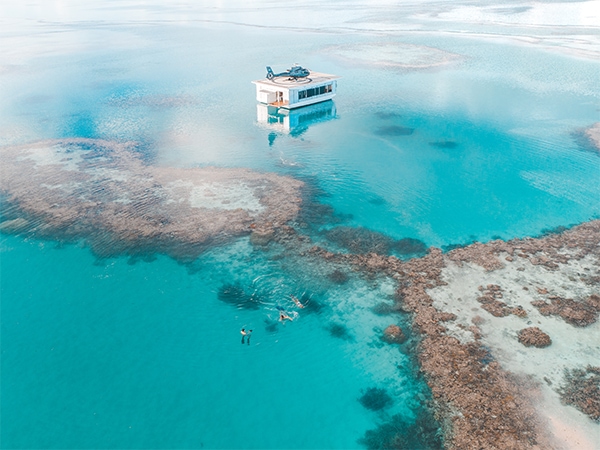
Find island bliss in The Whitsundays. (Credit Salty Wings)
Whether it’s your first time or your umpeenth time, there has never been a better time to visit Uluru than now. Last year’s closing of the controversial climb certainly marked a new chapter in the sandstone monolith’s age-old history and with it cast light on the myriad ways you can actually experience Australia’s spiritual heart.
There’s Bruce Munro’s mesmeric Field of Light, Indigenous experiences ranging from dot painting workshops to bush tucker tours. There’s sky diving, camels, Segways and Harley Davidsons.
There’s Opera Australia and exclusive dune-top dinner, Tali Wiru. There’s luxury wilderness camp Longitude 131°, with privileged views of Uluru afforded from the supreme comfort of your bed. And of course there’s the opportunity to simply pitch a tent and plug right into the living cultural landscape of the Red Centre at Ayers Rock Campground.
And it might just prove life-changing. After all, it was a camping trip to Uluru in 1992 that famously inspired Munro to conceptualise Field of Light.
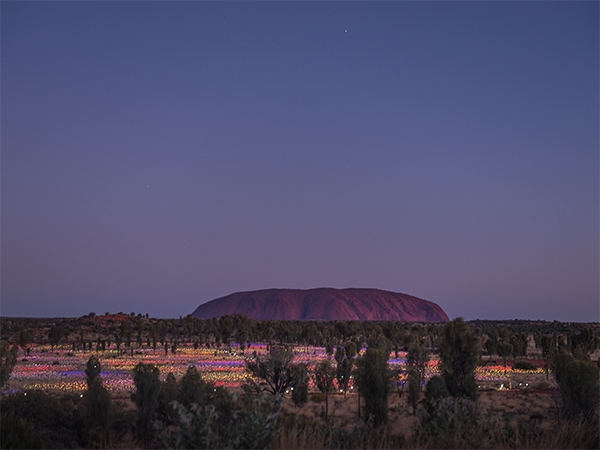
Plug into Uluru and Kings Canyon. (Credit Tourism NT/Matt Glastonbury)
Great Southern is the latest rail adventure from Journey Beyond. This three-day, two-night exploration of Australia’s south-east corner will travel between Brisbane and Adelaide (and vice versa) each summer, stopping off at sunkissed beaches and buzzing capitals and ticking off bucket-list items along the way.
The Adelaide to Brisbane journey takes in Victoria’s Grampians region, culture-rich Canberra and the NSW Mid North Coast town of Coffs Harbour. The Brisbane to Adelaide leg explores the vineyards of NSW’s Hunter Valley and Newcastle, before fast-forwarding to Victoria for a day spent either in Melbourne or coasting along Great Ocean Road to see the Twelve Apostles, and hitting up the Adelaide Hills. Take it up a gear with extended packages that roll on for up to eight days and encompass everywhere from the Barossa Valley to Byron Bay.
There will be plenty of time onboard, of course, where you can expect to enjoy the same golden era-of-travel-style experience as passengers on The Ghan and Indian Pacific are accustomed to: fine wining and dining and world-class hospitality.
Great Southern is the latest rail adventure from Journey Beyond.
Legendary guide Sab Lord, of Lords Safaris, has spent more than a quarter of a century leading specialised tours through the Kimberley, Kakadu and Arnhem Land, so you can bet he knows where the best bits are. Here, his top five wild swimming spots to take his guests to.
1. Koolpin Gorge – Jarrangbarni by its Aboriginal name – is not a place for the average tourist, and not many people get to see it. The walk up the gorge is a real wilderness walk and requires you to be comfortable in very rough terrain and to be reasonably fit. A stunning gorge with a creek running through and waterholes to swim in, only 40 people are allowed there at any time and you will also need a permit from Kakadu National Park.
2. The small but beautiful swimming hole in Arnhem Land at Davidson’s safari camp. Access it from April to August by booking a trip with them or through us at Lords Safaris.
3. One of the most spectacular swimming spots in the Kimberley, Upper Manning Gorge is located close to Mt Barnett Roadhouse, which is the gateway to Manning Gorge, on the Gibb River Road. The walk to upper Manning Gorge takes around three hours return. Enjoy this large, deep pool that’s fed by a powerful waterfall (which you can swim right under).
4. Allow four to six hours return to hike to Mitchell Falls in the Kimberley so that enough time can be spent there. Relax at Little Mertens Falls on the way, where a natural spa falls from the escarpment above. Rocky ledges, fern-covered walls and natural spring waters are all features of the area. Exploring Mitchell Plateau with its magnificent system of waterfalls and superb scenery, you will be able to swim in any number of waterways above the falls.
5. Maguk is probably one of Kakadu National Park’s lesser-known attractions, a pristine natural waterfall and plunge pool at the base of steep gorge walls where you might find yourself swimming with black bream. You get there by following a 14-kilometre 4WD track off the Kakadu Highway and then walking for a kilometre through monsoon forests and crossing over Barramundi Creek.
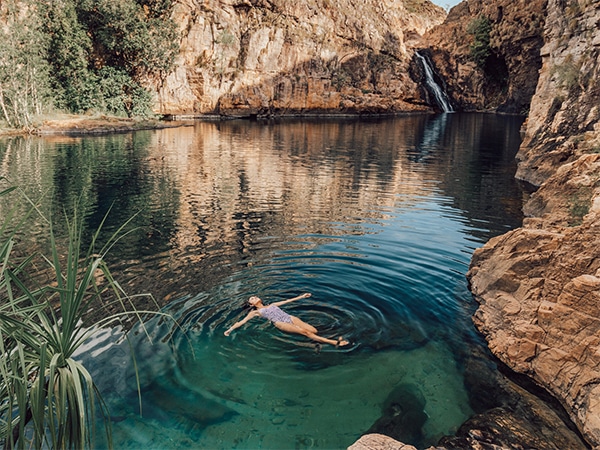
Seek out the best wild swimming spots in Kakadu. (Credit Tourism NT/Adriana Alvarado)
With more than 10,000 beaches to choose from in Australia (more than any other country in the world), there are plenty of sandy secret gems to make your own. Here, a hit list of beach holidays to come.
Mona Vale Beach on Sydney’s northern beaches for the stunning rock pools and local vibe.
Milk Beach in the eastern Sydney suburb of Vaucluse for the breathtaking view of the city skyline at sunset.
Twilight Beach in Esperance for its wide, white swathes of sand and great swimming.
Red Bluff, north of Carnarvon on the edge of the Ningaloo Reef Marine Park for the rugged coastal outback beauty and great surfing.
Myall Beach at Cape Tribulation for the convergence of two World Heritage sites: the Daintree and the Great Barrier Reef.
Blinky Beach on Lord Howe Island for its surfing, swimming and snorkelling.
Maslin Beach in South Australia’s Fleurieu Peninsula for its wide expanse and amazing multi-coloured cliffs.
Stokes Bay on the north coast of Kangaroo Island for its weaving approach through caves and around rocks, and secluded sandy beach.
Friendly Beaches in Tasmania’s Freycinet National Park for its middle-of-nowhere beauty and coastal bush walk.
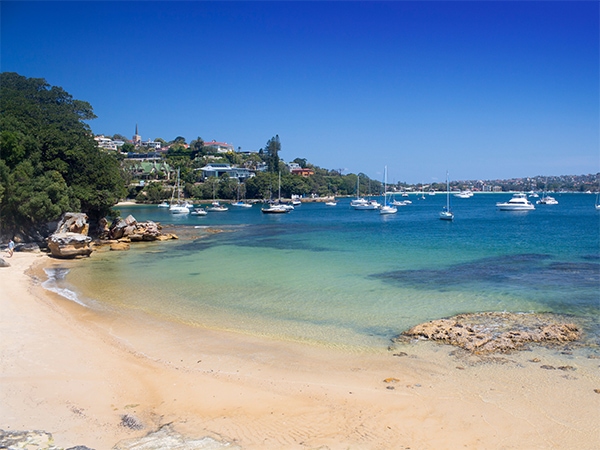
Spend time at some of Australia’s best kept secret beaches.
With the launch of a four-hour direct flight from Melbourne to Kununurra (aka the Kimberley Express) set to take place next May, the East Kimberley region will open up to east coast Australians in a whole new way. Travellers will be transported straight to the doorstep of some of the country’s most iconic outback destinations. Start planning now.
Kununurra itself is the gateway town to the East Kimberley – swelling with lakes, rivers and waterfalls, and the ideal place to start your exploration from. Don’t miss a rum tasting and lunch at Hoochery Distillery first.
Around an hour down the iconic Gibb River Road from Kununurra, the equally iconic El Questro is a destination in itself. At over 280,000 hectares in size, this cattle station-cum-wilderness retreat allows you to experience rugged ranges, deep gorges, breathtaking sunsets and ancient boab trees by day before retreating for the night on site. Choose between the accommodation or campgrounds of The Station, the safari-style tented cabins of Emma Gorge or the luxurious nine-suite El Questro Homestead.
Located 70 kilometres south of Kununurra, Lake Argyle is Australia’s largest expanse of freshwater. Take to the water on a cruise – sunset wins, hands down – and pitch a tent for a night or two at Lake Argyle Resort to really soak in the solitude. There are a number of walking trails around the lake that lead you through the rugged landscape and be sure to make good use of the resort’s infinity pool.
Deep within Purnululu National Park, some 250 kilometres south of Kununurra, the World Heritage-listed Bungle Bungles rise 300 metres out of grassy plains. These beehive-shaped orange-and-black-striped karst sandstone domes are among the world’s most interesting geological landmarks. Take to the skies in a helicopter to get a sense of their scale or go off-road on an overnight adventure to Bungle Bungle Savannah Lodge and visit the exquisite natural amphitheatre of red rock, Cathedral Gorge.
The highlight of the Kimberley’s cultural calendar, the Ord Valley Muster, just got closer. The region’s biggest annual festival takes place over 10 days each May with events ranging from exclusive food experiences to film and comedy nights, long-table dining, Indigenous celebrations and a rodeo. Or consider the Kimberley Writers Festival at the end of the dry season each year for one of the most unique literary events you’re likely to experience.
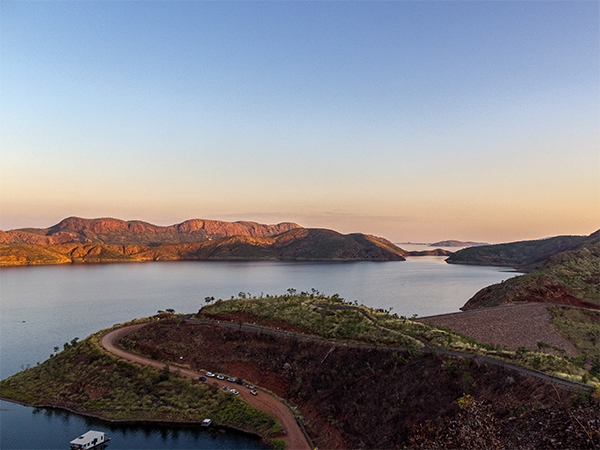
Explore the red rock wilderness of the East Kimberley.
Byron Bay is fixed in most people’s imaginations as a laid-back coastal idyll. Sun, sea and surf in endless supply. But Byron Shire boasts more than just beaches.
Heading inland from the coast to Byron’s lush hinterland will deposit you in any number of quaint villages and towns that are definitely worth exploration. Start with the delightful town of Bangalow, its main street lined with heritage shopfronts and cafes, and shopping in abundance.
Score a table under the wide verandah at Woods cafe, a sister to Byron Bay’s popular Folk, and order brunch from the plant-based, ethically sourced menu. Browse Bangalow Pharmacy, with its wooden shelves stocked with scents, lotions and candles; and Our Corner Store, a modern take on the general store. And make sure you take five minutes to duck into the Bangalow Hotel to see its lovely Art Deco interiors.
The sleepy town of Mullumbimby, 24 kilometres north from Byron, is all abuzz come Friday, when the local farmers’ market takes up residence in the showground from 7am until 11am; expect locally grown and organic produce, raw-food treats, handmade candles and fashions with a bright, breezy, hippy vibe.
Newrybar is another cute country town that has become something of a hotspot, with local creatives setting up shop here. Many can be found at Newrybar Merchants, a collective of “local artisans and curators of fine goods”. Any trip to the town has to also include a visit to the celebrated Harvest, with its artisan deli, bakery and a continually hatted restaurant.
A 15-minute drive from Newrybar you will find the last piece of the Byron hinterland puzzle: The Farm Byron Bay, another collective that includes a market garden, grazing cattle, nursery, bakery and restaurant from the Three Blue Ducks crew.
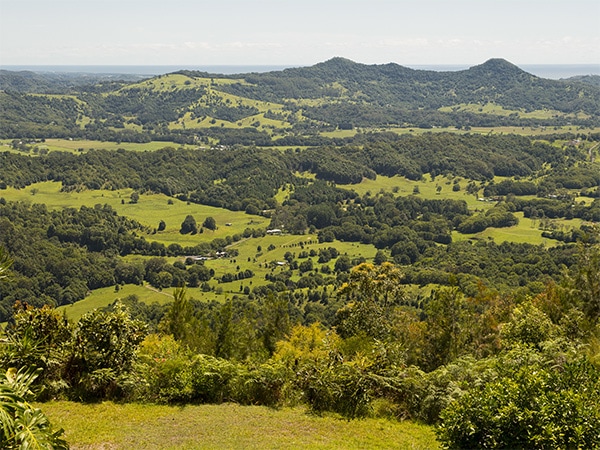
Discover the other side of Byron Bay. (Credit: Destination NSW)
Sure, we’re a sucker for a slick new design hotel or a carefully curated Airbnb, but we have a particular soft spot for a classic, too. Especially if that classic sits right on the doorstep of Tasmania’s spectacular, World Heritage-listed Cradle Mountain-Lake St Clair National Park.
A two-hour scenic drive from Launceston, Cradle Mountain Lodge is set lightly on this landscape and offers four different styles of accommodation, from the contemporary Pencil Pine Cabins to the luxurious King Billy Suites. It has the timeless feel of an alpine lodge and all the added benefits of Tasmanian produce, wine and warm hospitality.
But of course, the main reason you’re here is to explore the icons of the Tasmanian wilderness that are the towering Cradle Mountain with its ragged twin peaks and the picturesque Dove Lake that lies, mirror-like, at its foot.
Some of the mountain’s best – and easiest – hikes leave from the doorstep of Cradle Mountain Lodge. Choose from over 20 different self-guided walking tracks, ranging from gentle meanders through buttongrass plains and moss myrtle forests to clambering to the top of Dove Canyon, and the Dove Lake circuit walk, a six-kilometre jaunt and one of Tasmania’s best short walks.
And if you are game for taking on the Cradle Mountain summit hike itself, what better way to reward yourself than with a session in the Sanctuary – the Waldheim Alpine Spa’s dedicated therapeutic area, followed by a room-service platter of Tasmanian cheese by the log fire?
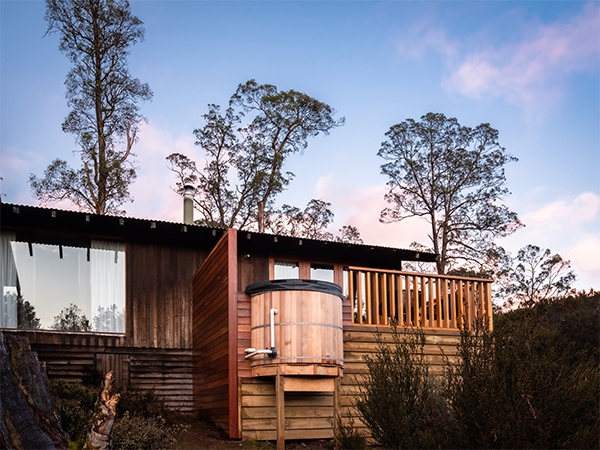
Cradle Mountain Lodge is set lightly on this landscape and offers four different styles of accommodation.
Thank you for sharing our great Southern land, have seen lot of Australia and more to do. Fabulous about flights direct to Kununara.